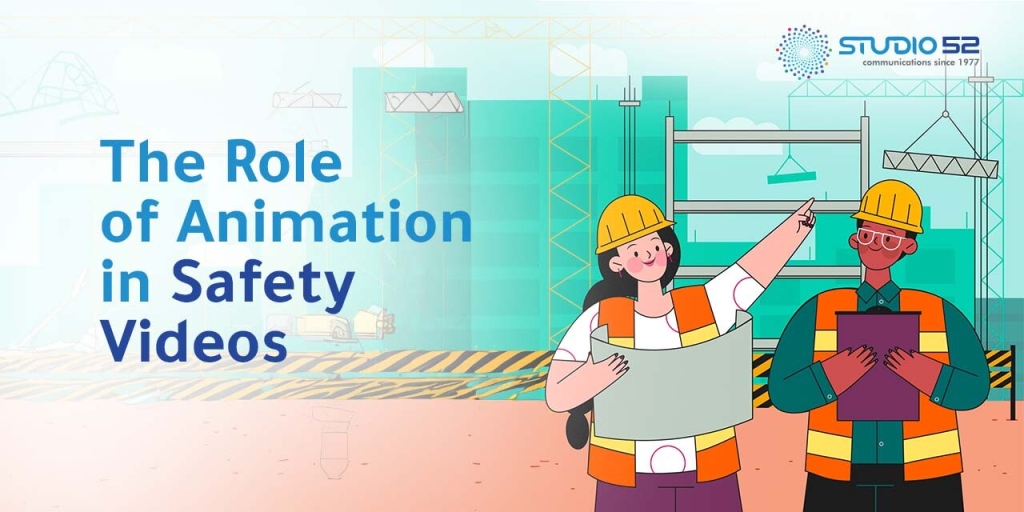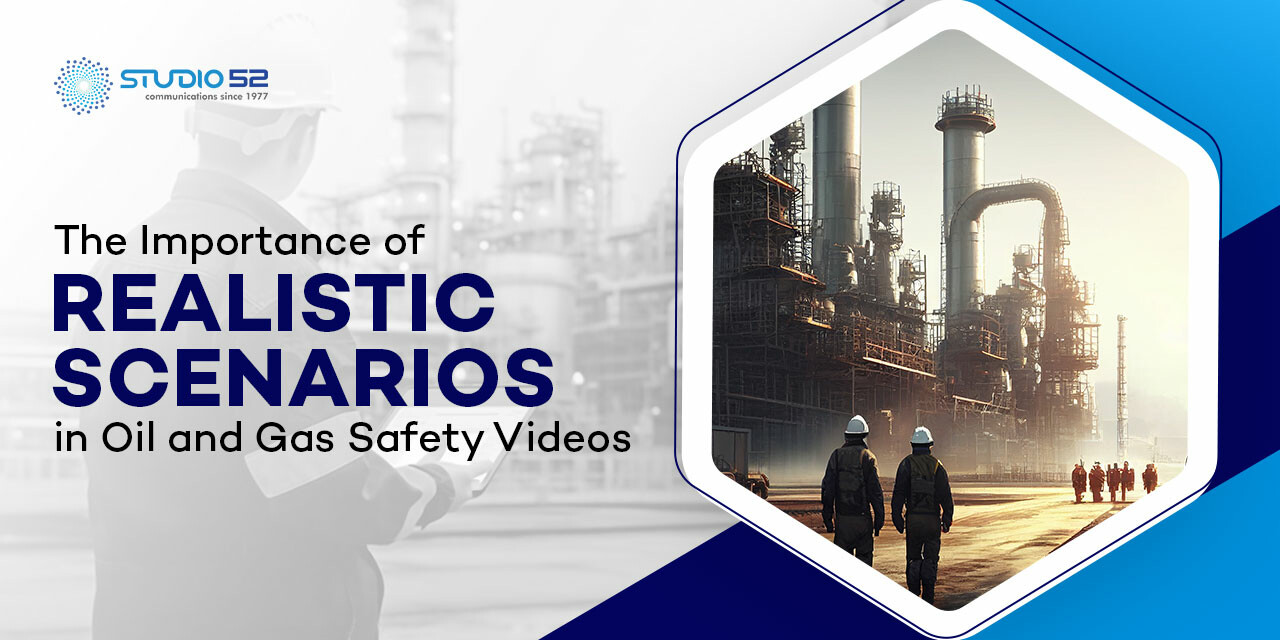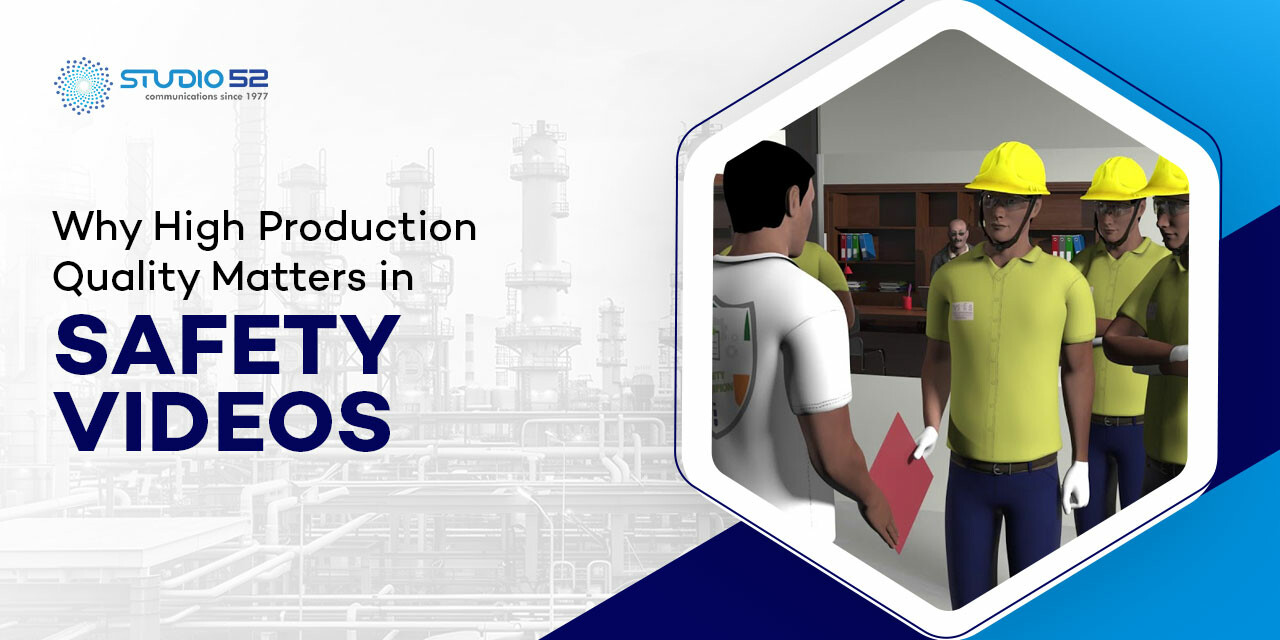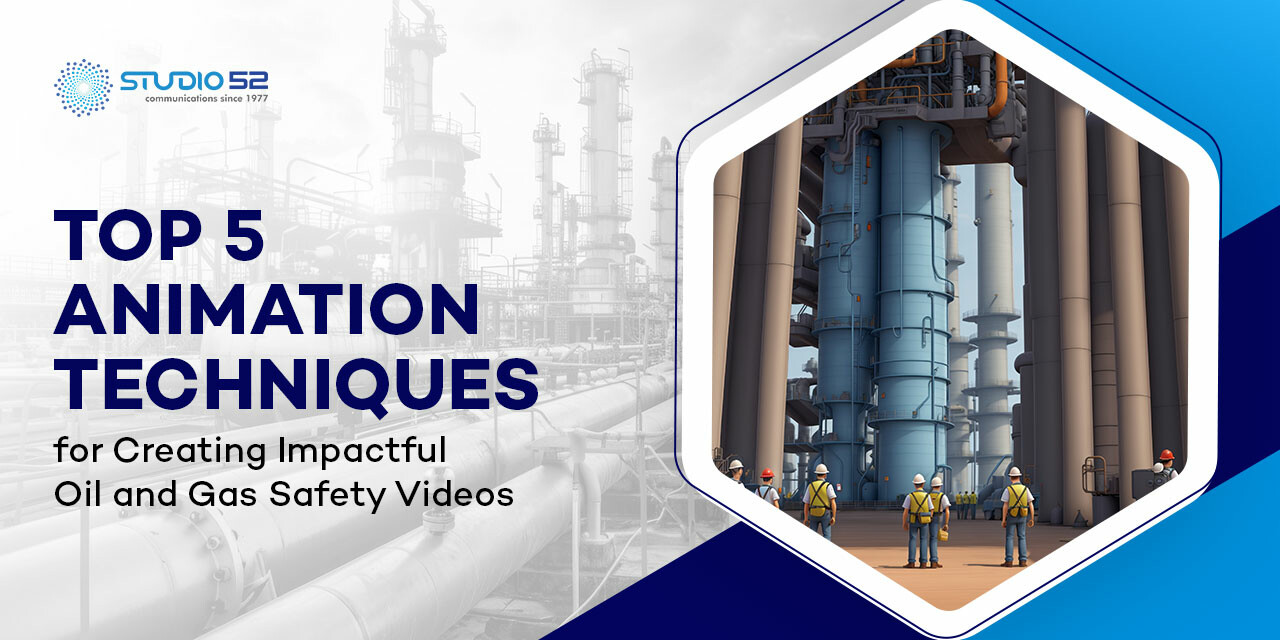Animation is a powerful tool in safety videos, offering clear communication and engaging visuals. It serves as both a training tool for your employees, as well as a constant reminder and easily accessible safety tool that can be used on the spot.
Whether it’s simplifying complex procedures or fostering a culture of awareness, animation delivers effective results. And it shows in a key simple stat — viewers are 95% more likely to retain the information seen in the video.
At Studio 52, we specialise in creating custom animations to meet your safety communication needs efficiently and within budget. And today, we’ll explore the significance, benefits, and applications of animation when enhancing your safety messages.
Table of Content
Animation in Safety Videos
Within the context of safety videos, animation embodies dynamic visual representations designed to convey essential safety procedures and protocols. Many industries can benefit from safety animation services. These include construction, manufacturing, oil and gas, mining, healthcare, transportation, hospitality, and retail. Safety animations help show important safety rules and emergency steps clearly. we make it easier for workers to understand and remember safety practices. Using these videos can reduce accidents and keep workers safer in all kinds of workplaces.
Its utilisation stems from its unparalleled ability to captivate audiences while delivering crucial information in a comprehensible manner.
2D animation is widely utilised for its simplicity and versatility. It involves creating graphics and characters in a two-dimensional space, offering a flat, cartoon-like aesthetic. 2D animation excels in illustrating step-by-step procedures, depicting safety hazards, and explaining complex concepts in an easily understandable manner. This straightforward approach makes it ideal for conveying basic safety instructions and guidelines.
3D animation adds depth and realism to safety videos by simulating three-dimensional environments and objects. It allows for more realistic representations of workplace scenarios, equipment, and procedures, enhancing viewer engagement and comprehension. 3D animation is particularly effective for demonstrating intricate machinery operations, conducting virtual walkthroughs of facilities, and simulating emergencies.
At Studio 52, we specialise in crafting custom animations tailored to our client’s specific safety communication needs. Whether it’s 2D or 3D animation, our team of skilled animators and content creators work closely with clients to develop engaging and informative safety videos that effectively convey critical information and drive positive behavioural change.
Studio52 has created many successful safety animation videos, such as those showing helmet use on construction sites or safe machine operation in factories. Our videos use clear language and bright visuals to keep workers focused. These animations help workers follow safety rules better and lower accident risks. Studio52’s videos are trusted by many companies to improve workplace safety training.
We can certainly share examples of safety animations we’ve made before. Our videos show important safety rules in easy and fun ways, using custom characters and clear animations. For example, we created animated videos about electrical safety, warehouse safety, and proper use of equipment. These animations help workers understand and remember safety tips better. weare designed to keep everyone safe while making learning simple and engaging. Just ask, and we’ll gladly show you!

Benefits of Animation in Safety Videos
Animation offers myriad advantages over conventional methods of safety video production. It imbues videos with an engaging quality, ensuring heightened viewer retention and comprehension.
By breaking down intricate safety protocols into visually digestible segments, animation makes it easier for viewers to understand and retain critical information. Animation enhances safety videos by infusing them with an engaging quality that captivates viewers’ attention. Unlike traditional methods of presenting safety information through text or live-action footage, it offers a dynamic and visually stimulating experience that encourages active participation and involvement.
Its vibrant colours, fluid movements, and interactive elements create a more immersive viewing environment, leading to heightened viewer interest and retention of key safety messages.
Moreover, animation allows for greater creativity and flexibility in portraying safety scenarios and concepts. Whether it’s depicting hypothetical workplace incidents, simulating emergencies, or illustrating best practices for safety compliance, animation offers endless possibilities for customization and adaptation to specific audience demographics and communication objectives.
This versatility enables organisations to tailor their safety videos to resonate with their target audience effectively, thereby maximising the impact and effectiveness of their safety communication efforts.
Selecting the Right Animation Service
If you opt for animations for your safety videos, partnering with the ideal animation service provider is vital for effectively communicating your goals. Consider these key factors during selection:
- Expertise Matters
Seek animation service providers experienced in creating safety videos. Review their work in similar industries or safety topics. Verify their comprehension of relevant safety protocols. An expert animation team translates complex concepts into visuals that engage your audience.
- Reputation Counts
Research potential providers’ reputations through portfolios, client testimonials, and industry recognition. A reputable provider boasts a portfolio of quality animations and satisfied client feedback. Additionally, consider their reliability, communication skills, and timely delivery.
- Quality and Style Impress
Evaluate factors like animation fluidity, character design, and visual aesthetics. Choose a provider whose style aligns with your safety video’s tone and message, whether whimsical for general awareness or realistic for specialised training.
- Customization and Collaboration Are Key
Finding animation companies collaborating throughout the production process ensures that videos meet requirements. Pick providers receptive to feedback, transparent about processes, and customising solutions.
- Budget and Timeline
Weigh budget and time constraints while selecting animation providers. Cost matters, but prioritise quality that effectively conveys the intended safety messages. Discuss upfront about the budget and timelines with potential providers, ensuring delivery within limits and maintaining quality.
At Studio 52, we take pride as MENA Region’s trusted content partner offering tailored expert animation services aligned with clients’ safety communication objectives. Our expertise, reputation, and commitment to excellence help achieve consistently successful safety videos for diverse industries over years.
Examples of 2D Animation in Safety Videos
Illustrative examples of safety videos employing 2D animation underscore the efficacy of this approach.
Take our work for the CCE Development and how we utilised 2D animation video to help them explain their Safe System of Work. In this short but comprehensive video, we covered all aspects of safe working and saved them plenty of time and resources, along with the struggle involved in explaining the process to the recruits and crew members.
Another noteworthy instance is of Foresight and how we helped them achieve a fatality-proof workplace. In the short two-minute video reel, we helped them explain perils and safety procedures when working on an oil rig.
Examples of 3D Animation in Safety Videos
Like 2D animations, we have numerous instances for the effectiveness of 3D animation video production as well. Sharp Eagle was a partner on many projects and has helped more than a few clients achieve success with the power of 3D animation.
Our prime example is the 3D video of the architectural project for The Rhythm. In just four short minutes, we helped them showcase their project and its main attributes.
You can use such 3D videos to showcase your products as well. Watch how we produced a 3D video for DSI to present their bypass system to their buyers. This 9-minute long engaging video guide helped the buyers get familiar with everything – from the function and the process to the effectiveness of the product. The potential animated videos from a sales perspective is endless.
Creating an Animated Safety Video
Creating the best-animated videos comes in a few stages. And we make sure we focus on each to produce the best end version for your brand needs.
- Scriptwriting
The first step in creating an animated safety video is developing a comprehensive script. This involves outlining the key safety messages, scenarios, and dialogue that will be depicted in the video. The script should be clear, concise, and tailored to the target audience, ensuring that critical safety information is effectively communicated.
- Storyboarding
Once the script is finalised, the next step is to create a storyboard that outlines the visual sequence of the video. Storyboarding involves sketching out each scene and determining the framing, camera angles, and character movements. This provides a visual roadmap for the animation team and helps ensure that the narrative flows smoothly from scene to scene.
- Character Design and Animation
With the storyboard as a guide, the animation team begins creating the characters and animating the scenes. This may involve designing custom characters, backgrounds, and props that align with the style and tone of the safety video. The animation process brings the script and storyboard to life, with characters moving, interacting, and conveying safety messages through visual storytelling.
- Voiceover and Audio
Voiceover recordings and audio effects are produced to accompany the visual elements of the video. A professional voice actor may be hired to narrate the script, while sound effects and background music are added to enhance the overall impact and immersion of the safety video. Our team of in-house voice actors and producers at Studio52 allow us to be extremely time-efficient at this step.
- Review and Revision
Throughout the production process, regular reviews and revisions are conducted to ensure that the safety video meets the client’s expectations and aligns with the project objectives. Feedback from stakeholders and subject matter experts is incorporated to refine the animation, scripting, and audio elements as needed.
- Final Production
Once all elements are finalised and approved, the animated safety video is rendered into its final format. This involves combining the animation, voiceover, and audio components into a cohesive video file ready for distribution. Quality control checks are conducted to ensure that the video meets technical specifications and maintains consistency with the client’s branding and messaging.
Optimizing Safety Videos for Effectiveness
Your safety video is never truly done. With changes in your insights, available technology, and team experience, these videos are bound to evolve in quality and effectiveness in conveying the safety message. Here are a few ways to optimise your safety videos.
- Crafting Compelling Calls to Action
Optimising safety videos means including calls for action (CTA) – asking viewers to perform a certain action, usually once the video is near completion. They could be about following safety rules, reporting dangers, or taking training. Action requests need to be clear and fit the video’s safety goals. Having viewers engage in safe behaviours is the aim. Calls to action should be short, concise, and related to the video. Each CTA should line up with overall safety purposes, highlighting the importance of letting the viewers know the importance of the provided safety actions in real life. An effective call to action allows simple awareness to create real behaviours that improve workplace safety.
- Engaging Viewers Emotionally
Emotional engagement is a powerful driver of behaviour change, making it essential to incorporate elements that resonate with viewers on a personal level. Safety videos can foster a deeper connection with viewers and motivate them to prioritise safety in their actions by evoking emotions such as empathy, concern, or determination. Real-life testimonials, relatable scenarios, and storytelling techniques can all enhance emotional engagement and reinforce the importance of safety practices.
- Utilizing Interactive Elements
Interactive elements such as quizzes, surveys, or simulations can enhance viewer engagement and facilitate active participation in safety videos. By allowing viewers to interact with the content, safety videos become more immersive and memorable, leading to better retention of key messages and increased likelihood of behavioural change. Interactive elements can also provide valuable feedback to stakeholders, allowing for continuous improvement and refinement of safety initiatives.
- Employing Rigorous Testing Methodologies
Testing and evaluation are critical components of optimising safety videos for effectiveness. Before deployment, safety videos should undergo rigorous testing to ensure that they resonate with the target audience, convey key messages clearly, and drive desired outcomes. This may involve conducting focus groups, surveys, or usability testing to gather feedback from representative viewers and identify areas for improvement. Iterative testing allows for refinement of the video content and enhances its ability to achieve the intended safety objectives.
- Measuring Impact and ROI
Finally, optimising safety videos requires ongoing measurement and evaluation of their impact and return on investment (ROI). By tracking metrics such as viewer engagement, completion rates, knowledge retention, and behaviour change, organisations can assess the effectiveness of their safety videos and make data-driven decisions for future initiatives. Additionally, conducting cost-benefit analyses can help quantify the ROI of safety videos in terms of reduced accident rates, improved compliance, and other tangible benefits to the organisation.
Conclusion
Animation emerges as a pivotal tool in safety video production, offering unparalleled effectiveness in conveying critical information and fostering engagement. As safety remains a top priority across various industries, harnessing the power of animation proves to be a strategic and impactful approach.
Studio52 stands as a leading animation service provider, renowned for its expertise in crafting compelling safety videos. With a commitment to excellence and a track record of delivering tailored solutions, Studio52 is poised to elevate your safety video endeavours to new heights.
Whether you require 2D or 3D animation, interactive elements, or immersive storytelling, Studio52’s team of skilled animators, content creators, and safety experts are dedicated to bringing your safety vision to life. With a focus on quality, reliability, and customer satisfaction, Studio52 strives to exceed expectations and deliver impactful safety videos that make a difference in the workplace.
Partner with Studio52 for your next safety video project and experience the difference expert animation services can make. Together, we can create safety videos that inspire action, promote compliance, and contribute to a safer and more productive work environment.
FAQs
What is safety animation?
Safety animation is the use of animated visuals and storytelling techniques to convey essential safety information, procedures, and best practices. It simplifies complex concepts, making them easier to understand and remember, ultimately promoting a culture of safety in the workplace.
Who needs safety animations?
Safety animations are beneficial for organisations across all industries, from manufacturing and construction to healthcare and hospitality. Any organisation concerned with the safety and well-being of its employees and stakeholders can benefit from the use of safety animations to communicate critical information effectively.
What is the ideal duration for a safety animation video?
The ideal duration for a safety animation video depends on the complexity of the content and the attention span of the target audience. Generally, safety animation videos range from one to five minutes in length. It’s essential to balance thoroughness with brevity to ensure that viewers remain engaged and absorb the key safety messages effectively.
How often should safety animation videos be updated?
Safety animation videos should be updated periodically to reflect changes in safety protocols, regulations, and best practices. The frequency of updates may vary depending on factors such as industry standards, organisational policies, and evolving safety risks. It’s recommended to review and update safety animation videos at least annually to ensure that they remain accurate, relevant, and effective in promoting workplace safety.






